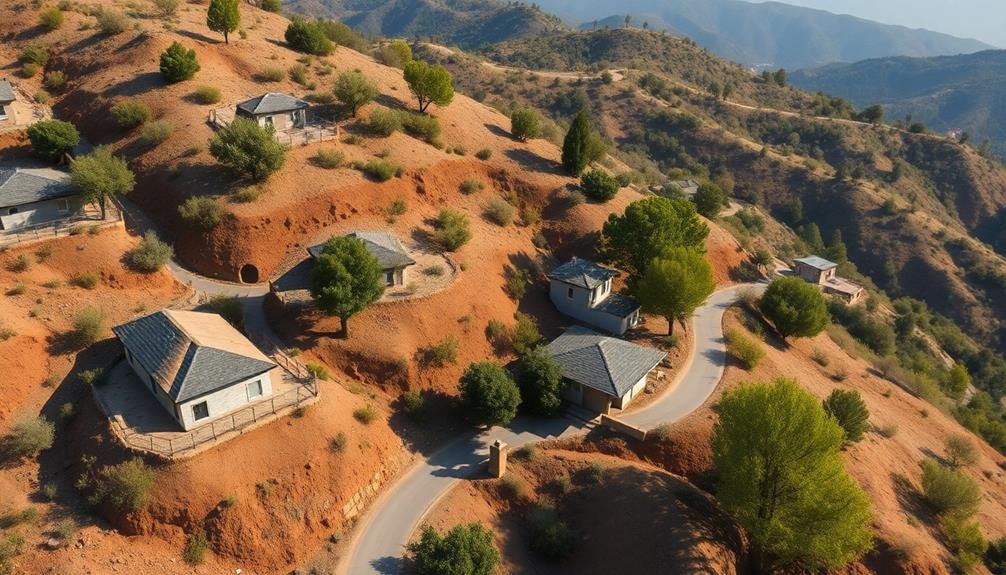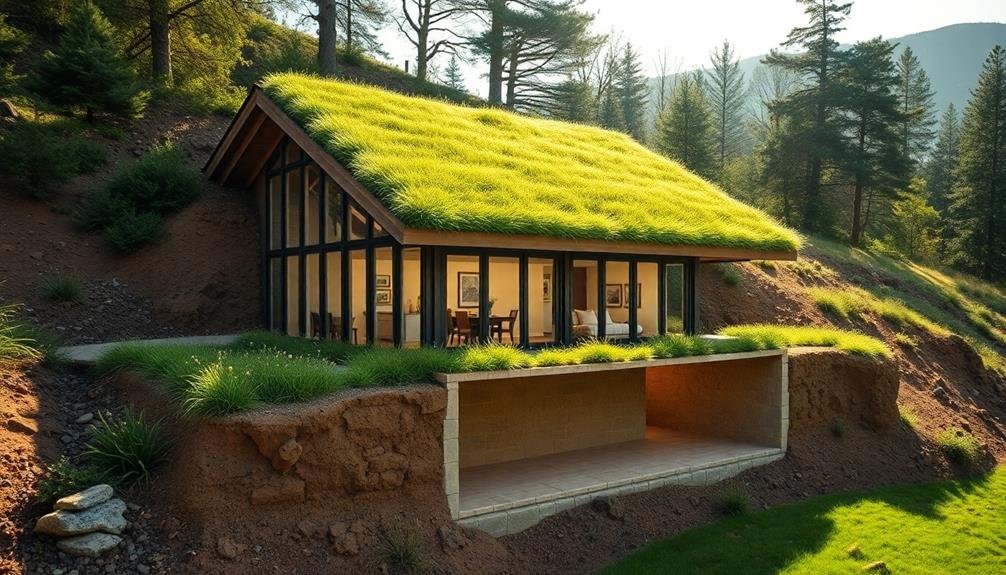Earth-sheltered homes can dramatically reduce your energy costs through passive design strategies. By utilizing the earth's natural insulation, you'll benefit from stable indoor temperatures year-round. Proper orientation and large windows maximize natural lighting and solar heat gain. Thermal mass absorbs and releases heat slowly, while high-quality insulation maintains the thermal envelope. Ventilation systems guarantee fresh air circulation and temperature control. Cooling techniques like earth tubes and geothermal systems tap into the ground's consistent temperature. When planning your earth-sheltered home, consider local climate, topography, and soil conditions to optimize energy efficiency. Discover how these design elements work together to create a sustainable, comfortable living space.
Earth-Sheltered Home Basics

In earth-sheltered homes, the structure is partially or fully surrounded by earth. This design approach offers numerous benefits, including energy efficiency, noise reduction, and protection from extreme weather.
You'll find two main types of earth-sheltered homes: earth-bermed and underground. Earth-bermed homes have earth pushed up against the exterior walls, while underground homes are built entirely below ground level.
When constructing an earth-sheltered home, you'll need to take into account several key factors. Proper waterproofing is essential to prevent moisture infiltration. You'll also need to guarantee adequate ventilation and natural lighting through strategically placed windows and skylights.
The structure must be designed to withstand the pressure of the surrounding earth, often requiring reinforced concrete or other sturdy materials.
Earth-sheltered homes can greatly reduce your heating and cooling costs due to the earth's natural insulating properties. They're also less susceptible to temperature fluctuations, maintaining a more consistent indoor climate year-round.
Additionally, these homes offer enhanced privacy and security, as well as a reduced visual impact on the landscape. While initial construction costs may be higher, the long-term energy savings and durability make earth-sheltered homes an attractive option for environmentally conscious homeowners.
Thermal Mass and Insulation
Earth-sheltered homes' thermal performance hinges on two essential elements: thermal mass and insulation.
Thermal mass refers to the earth surrounding your home, which acts as a natural temperature regulator. It absorbs heat during warm periods and releases it when temperatures drop, creating a stable indoor climate year-round.
To maximize this effect, you'll need proper insulation. Insulate the walls, roof, and floor that are in contact with the earth to prevent heat loss and moisture penetration. Use high-quality, moisture-resistant insulation materials like extruded polystyrene or polyurethane foam.
Don't forget to insulate any exposed surfaces, such as windows and doors, to maintain the thermal envelope.
The combination of thermal mass and insulation works synergistically to reduce your home's energy needs. In summer, the earth's cool temperature helps keep your home comfortable without excessive air conditioning.
In winter, the stored heat in the thermal mass reduces your heating requirements. By strategically placing windows for natural light and ventilation, you'll further enhance your home's energy efficiency.
Natural Lighting Strategies

Sunlight plays an essential role in earth-sheltered homes, despite their underground nature. You'll need to carefully plan natural lighting strategies to guarantee your living spaces are bright and inviting.
Start by orienting your home's exposed side towards the south to maximize sunlight exposure throughout the day. This orientation allows you to incorporate large windows or glass doors that flood your interior with natural light.
Consider implementing clerestory windows, which are high windows placed near the ceiling. They're excellent for bringing light deep into your home's interior without compromising privacy or thermal efficiency.
Skylights are another effective option, especially for rooms that don't have direct access to the exposed side of your home. You can use light tubes or solar tubes to channel sunlight from the roof to interior spaces that are further underground.
Don't forget about reflective surfaces. Use light-colored walls, ceilings, and floors to bounce light around your home, making spaces feel brighter and more open.
Strategically placed mirrors can also help distribute natural light throughout your earth-sheltered home, reducing the need for artificial lighting during daylight hours and contributing to overall energy efficiency.
Ventilation and Cooling Systems
Proper ventilation and cooling systems are essential for maintaining a comfortable and healthy environment in earth-sheltered homes. You'll need to implement strategies that guarantee adequate air circulation and temperature control, as these structures can be prone to moisture buildup and overheating.
Consider installing a mechanical ventilation system with heat recovery to maintain air quality while minimizing energy loss. You can also incorporate natural ventilation techniques, such as strategically placed windows and vents, to promote airflow throughout your home.
For cooling, you've got several options:
| Cooling Method | Effectiveness |
|---|---|
| Earth tubes | High |
| Geothermal | Very high |
| Solar chimney | Moderate |
| Night flushing | High |
| Evaporative | Climate-dependent |
Earth tubes and geothermal systems leverage the stable ground temperature to cool your home efficiently. A solar chimney can create a natural draft to expel hot air, while night flushing takes advantage of cooler nighttime temperatures. Evaporative cooling works well in dry climates but may not be suitable for humid areas.
Site Planning Considerations

When planning your earth-sheltered home, careful consideration of the site is essential for maximizing energy efficiency and ensuring long-term comfort.
Start by evaluating the local climate and topography. You'll want to orient your home to take advantage of passive solar heating and natural cooling. South-facing slopes in the Northern Hemisphere are ideal, as they receive maximum sunlight during winter months.
Examine soil conditions to determine the best foundation type and waterproofing methods. Well-draining soil is vital to prevent moisture issues.
Consider the water table and potential for flooding when selecting your building site.
Don't overlook vegetation. Existing trees can provide natural shading and windbreaks, but you'll need to balance this with solar access.
Plan for proper drainage around the structure to prevent water accumulation against the walls.
Access to utilities and road connections should also factor into your site selection. You may need to budget for extending services to more remote locations.
Lastly, check local building codes and zoning regulations. Some areas may have restrictions on earth-sheltered homes or require special permits.
Frequently Asked Questions
How Much Does It Cost to Build an Earth-Sheltered Home?
You'll find earth-sheltered homes typically cost $200-$300 per square foot. However, prices can vary widely based on location, design complexity, and materials used. Remember, you'll likely save on energy costs long-term with this efficient housing option.
Are Earth-Sheltered Homes Prone to Moisture or Mold Issues?
You're right to be concerned about moisture in earth-sheltered homes. They can be prone to mold if not properly designed and built. However, with proper waterproofing, ventilation, and drainage systems, you'll effectively prevent these issues in your earth-sheltered home.
Can Earth-Sheltered Homes Be Built in Areas With High Water Tables?
You can build earth-sheltered homes in areas with high water tables, but it's challenging. You'll need extensive waterproofing, proper drainage systems, and careful site selection. It's essential to work with experienced professionals to address potential moisture issues effectively.
How Long Does It Typically Take to Construct an Earth-Sheltered Home?
You'll find that earth-sheltered homes typically take 6-12 months to build. However, your timeline can vary based on design complexity, site conditions, and local regulations. Don't forget to factor in extra time for unique features and approvals.
Are There Special Insurance Considerations for Earth-Sheltered Homes?
You'll need specialized insurance for your earth-sheltered home. Standard policies may not cover unique risks like water seepage or structural issues. Contact insurers experienced with alternative homes to guarantee you're properly protected. Don't forget to shop around for the best rates.
In Summary
You've now explored the key elements of earth-sheltered homes and their passive design benefits. By embracing thermal mass, strategic insulation, and natural lighting, you'll greatly reduce energy costs. Don't forget to plan your ventilation and cooling systems carefully. When you're choosing a site, consider factors like orientation and soil conditions. With these principles in mind, you're well-equipped to create an energy-efficient, comfortable earth-sheltered home that works in harmony with its surroundings.





Leave a Reply